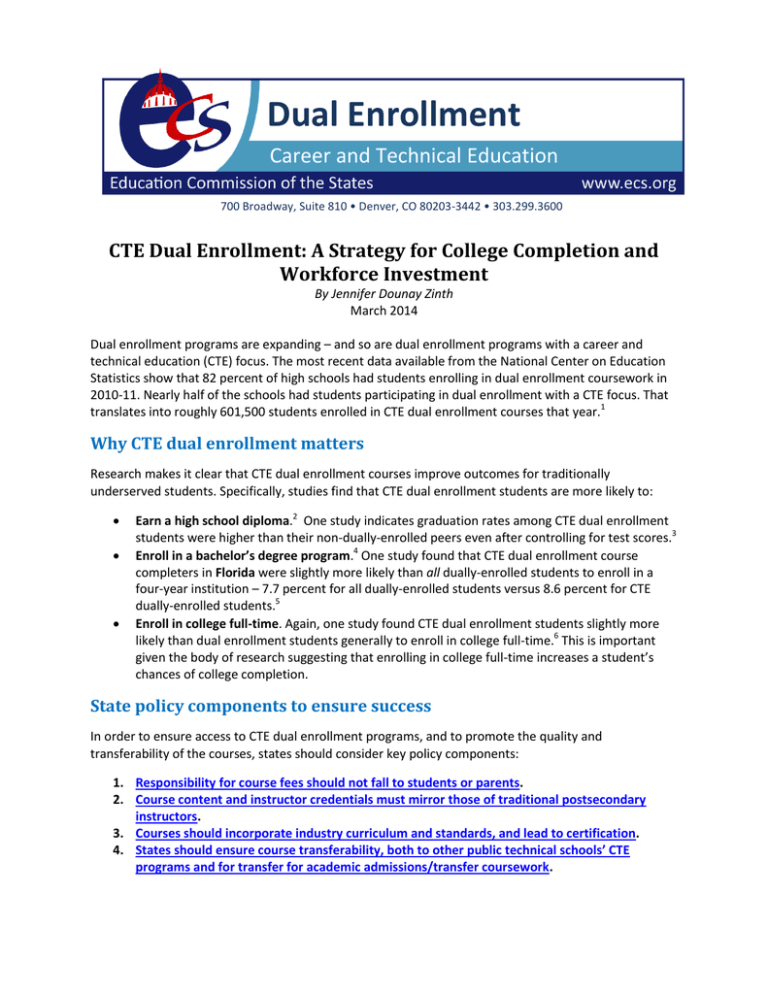
Dual Enrollment
Career and Technical Education
700 Broadway, Suite 810 • Denver, CO 80203-3442 • 303.299.3600
CTE Dual Enrollment: A Strategy for College Completion and
Workforce Investment
By Jennifer Dounay Zinth
March 2014
Dual enrollment programs are expanding – and so are dual enrollment programs with a career and
technical education (CTE) focus. The most recent data available from the National Center on Education
Statistics show that 82 percent of high schools had students enrolling in dual enrollment coursework in
2010-11. Nearly half of the schools had students participating in dual enrollment with a CTE focus. That
translates into roughly 601,500 students enrolled in CTE dual enrollment courses that year.1
Why CTE dual enrollment matters
Research makes it clear that CTE dual enrollment courses improve outcomes for traditionally
underserved students. Specifically, studies find that CTE dual enrollment students are more likely to:
Earn a high school diploma.2 One study indicates graduation rates among CTE dual enrollment
students were higher than their non-dually-enrolled peers even after controlling for test scores.3
Enroll in a bachelor’s degree program.4 One study found that CTE dual enrollment course
completers in Florida were slightly more likely than all dually-enrolled students to enroll in a
four-year institution – 7.7 percent for all dually-enrolled students versus 8.6 percent for CTE
dually-enrolled students.5
Enroll in college full-time. Again, one study found CTE dual enrollment students slightly more
likely than dual enrollment students generally to enroll in college full-time.6 This is important
given the body of research suggesting that enrolling in college full-time increases a student’s
chances of college completion.
State policy components to ensure success
In order to ensure access to CTE dual enrollment programs, and to promote the quality and
transferability of the courses, states should consider key policy components:
1. Responsibility for course fees should not fall to students or parents.
2. Course content and instructor credentials must mirror those of traditional postsecondary
instructors.
3. Courses should incorporate industry curriculum and standards, and lead to certification.
4. States should ensure course transferability, both to other public technical schools’ CTE
programs and for transfer for academic admissions/transfer coursework.
The case for integrating CTE into dual enrollment programs
Some studies have shown CTE dual enrollment may be a particularly effective college completion and
workforce investment strategy for low-income students and males.
Analysis of Florida data on CTE dual enrollment students discovered that “in many cases, male and lowincome students benefitted more from dual enrollment participation than their more advantaged
peers.”7 Specifically, CTE dual enrollment participation had a greater impact on male than female
students in terms of first-year college GPA and persistence to a second year of postsecondary
education.8
As eloquently phrased in a 2013 dual enrollment study completed for the state of Tennessee,
“Completion goals can only be achieved if all students are part of the postsecondary pipeline. Ensuring
that students who might not have gone to college in the past – low-income students, first-generation
college-goers, students who are interested in career and technical education – enter and succeed in
postsecondary education is essential to increasing the overall percentage of college completers within
the state.” 9 [Emphasis added]
It has also been noted that CTE dual enrollment courses allow students to try out different career paths,
and that “a hands-on CTE course may provide [struggling] students with a better chance of being
successful than a college-level academic course.” The paper cites students in one program with poor
grades in high school courses posting higher grades in their dual-enrollment renewable energy course.10
And in purely practical terms, supporters of CTE dual enrollment raise the fact that dual enrollment
allows high schools to expand CTE offerings without the need to purchase expensive equipment.
The authors of one widely-cited study point out “Many schools, particularly those in small or cashstrapped districts, cannot afford the equipment necessary to prepare students for technical fields but
community colleges often invest in such equipment. By enabling high school students to take courses on
a college campus where such resources are available, high school CTE programs can expand options for
students without additional drain on their resources.”11
1. Responsibility for course fees should not fall to students or parents
Data from the 2013 analysis by the National Center for Education Statistics indicate that course fees
could pose barriers to student participation in CTE dual enrollment coursework – 34 percent of high
schools with students enrolled in CTE dual enrollment courses reported that students were primarily
responsible for paying course fees.12 While course fees may be nominal in an academically-oriented dual
enrollment course, fees for postsecondary CTE courses may be quite substantial.
As an example, in Illinois, welding is among the top 10 most popular dual enrollment courses. However,
course materials can be quite costly for welding courses. At Illinois Valley Community College, for
instance, books and supplies for a four-semester Welding Production Certificate come to $1,911.
Education Commission of the States, www.ecs.org, page 2
Some states such as Florida make clear that any dual enrollment student enrolled at a public
postsecondary institution is exempt from paying course fees.13
2. Course content and instructor credentials must mirror those of
traditional postsecondary instructors
The 2013 NCES data suggest that states should set measures in place to ensure course rigor – 67 percent
of high schools with students enrolled in CTE dual enrollment courses reported that only high school
instructors taught these courses.14 Without measures to verify course quality, neither students, the
postsecondary institutions they may transfer into nor their future employers can be sure that the course
content of the dual enrollment course is equivalent to the content students would have received
through a traditional postsecondary course.
Fortunately, multiple avenues are available to states to assure course quality. The National Alliance of
Concurrent Enrollment Partnerships (NACEP), which accredits applicant concurrent enrollment
programs that meet NACEP’s 17 rigorous standards, includes among its accredited members programs
that offer general education and CTE courses, and programs that offer only CTE coursework.15 Some
states have incorporated NACEP standards into regulations governing both academic and CTE dual
enrollment programs. Other states such as Illinois have enacted program requirements similar to the
NACEP standards.16
Texas requires CTE dual enrollment courses to be college-level technical education courses listed in the
state’s Workforce Education Course Manual.17
Research highlights
What the data show
CTE dual enrollment students are more likely than their peers who did not dually enroll to:
Earn a high school diploma.18 One study indicates graduation rates among CTE dual
enrollment students were higher than their non-dually-enrolled peers even after controlling
for test scores.19
Enroll in a bachelor’s degree program.20 One study found that CTE dual enrollment course
completers in Florida were slightly more likely than all dually-enrolled students to enroll in a
four-year institution - 7.7 percent for all dually-enrolled students versus 8.6 percent for CTE
dually-enrolled students.21 The same study found CTE dual enrollment students in New York
City were 9.7 percent more likely than their non-dually-enrolled peers in high school CTE
programs to enroll in a baccalaureate degree program after high school graduation.22
Enroll in college full-time. Again, one study found CTE dual enrollment students slightly more
likely than dual enrollment students generally to enroll in college full-time.23 This is important
given the body of research suggesting that enrolling in college full-time increases a student’s
chances of college completion.
Not enter remedial coursework upon college entry.24
Have higher college persistence rates.25
Growth
Education Commission of the States, www.ecs.org, page 3
3. Courses should incorporate industry curriculum and standards, and
lead to certification
On a related note, it is critical that CTE dual enrollment courses integrate industry curriculum and
standards, and lead to industry certification. Courses that do not integrate these curricula and
standards, or do not lead to certification, are of limited value and a poor investment of student, district
and institutional time and resources. Fortunately, some states have taken steps to ensure courses are
aligned to industry needs and lead to industry-recognized credentials.
Florida requires “career dual enrollment” to be provided as an option for students to earn industry
certifications that count as credits toward the high school diploma. Further extending student
opportunities, “career early admission” is a type of career dual enrollment that allows students to enroll
full-time at a career center or Florida College System campus in programs leading to industry
certifications creditable both to the high school diploma and certificate or associate’s degree. As with
other dual enrollment options in the state, career early admission students are exempt from paying
registration, tuition and laboratory fees.26
By the numbers
Growth in CTE dual enrollment
In 2013, the National Center on Education Statistics published survey data on dual enrollment
course-taking in the 2010-11 school year. The data reveal that:
82 percent of high schools had students enrolled in dual enrollment coursework.
Nearly half – or 49 percent – of these high schools had students participating in CTE dual
enrollment.
This translates into roughly 601,500 students enrolled in CTE dual enrollment courses in
2010-11.
In comparison, CTE dual enrollment courses comprised 400,000 enrollments in 2002-03.
The change in student enrollment between 2002-03 and 2010-11 represents a yearly
growth rate of 5.3 percent.
4. States should ensure course transferability
If credits are not recognized for transfer when a high school graduate enters higher education, dual
enrollment loses its potential to save students (and their parents) tuition costs, avoid duplication of
services between institutions and reduce students’ time to degree.
Recent state activity suggests a shift towards dual enrollment and away from the former Tech Prep
articulated credit model. Under the articulated credit model, a student earned high school credit for a
postsecondary course but earned postsecondary credit only if the student enrolled after high school
graduation in the two-year institution or career tech center that had partnered with the student’s high
school, or if the course was a recognized course in the statewide articulation agreement. This trend
away from articulated credit expands the transferability of CTE dual enrollment courses.
Education Commission of the States, www.ecs.org, page 4
In an encouraging trend, policies in 22 states require all public two- and four-year institutions to accept
college credits earned through dual enrollment programs.
States should also consider means to allow CTE dual enrollment credits to be recognized as “academic”
credit should a student’s interest change. Louisiana legislation enacted in 2013 directs the Statewide
Articulation and Transfer Council to develop “academic transfer modules” to award and transfer credit
for the academic content embedded in CTE and industry-based certification courses, including for
courses offered through dual enrollment partnerships.27
The author wishes to thank Adam Lowe, executive director, National Alliance of Concurrent Enrollment
Partnerships; Kate Blosveren Kreamer, Associate Executive Director, National Association of State
Directors of Career Technical Education Consort; and Scott Stump, Assistant Provost, Career and
Technical Education, Colorado Community College System, for their guidance in developing this report.
Jennifer Dounay Zinth is a senior policy analyst and co-director of the Information Clearinghouse at the
Education Commission of the States. Contact her at jdounay@ecs.org.
For more information
Additional ECS resources on this issue include:
Increasing Student Success in Dual Enrollment Programs: 13 Model State-Level Policy Components
ECS identified 13 model state-level policy components that may increase student participation and
success in dual enrollment programs. These components fall under four broad categories: access,
finance, ensuring course quality and transferability of credit. Examples of state laws containing these
components are incorporated throughout this report. (Jennifer Dounay Zinth, ECS, February 2014)
Dual Enrollment Online Database
ECS’ 50-state online database includes a state-by-state breakdown on 20 data points about dual
enrollment, as well as comprehensive state profiles. (Jennifer Dounay Zinth, ECS, December 2013)
About ECS
The Education Commission of the States was created by states, for states, in 1965. We track policy,
translate research, provide unbiased advice and create opportunities for state policymakers to learn
from one another.
The conclusions presented in this report are those of ECS, which receives the majority of its funding
from the states and territories it serves. As part of the services ECS provides to states, staff members are
available for consultation and to serve as third-party experts in legislative hearings.
Education Commission of the States, www.ecs.org, page 5
Endnotes
1
Thomas, N., Marken, S., Gray, L., and Lewis, L. (2013). Dual Credit and Exam-Based Courses in U.S. Public High
Schools: 2010–11 (NCES 2013-001). U.S. Department of Education. Washington, DC: National Center for Education
Statistics.
2
Melinda Mechur Karp, Juan Carlos Calcagno, Katherine L. Hughes, Dong Wook Jeong, Thomas R. Bailey,
Community College Research Center, Teachers College, Columbia University, The Postsecondary Achievement of
Participants in Dual Enrollment: An Analysis of Student Outcomes in Two States, October 2007; Katherine L.
Hughes, Olga Rodriguez, Linsey Edwards and Clive Belfield, Community College Research Center, Teachers College,
Columbia University, Broadening the Benefits of Dual Enrollment: Reaching Underachieving and Underrepresented
Students with Career-Focused Programs, July 2012.
3
Hughes et al., p. 21
4
Hughes et al., p. 22
5
Karp et al., pp. 5, 28
6
Karp et al., pp. 29-30
7
Karp et al, p. 55
8
Karp et al., p. 58, 61, 63
9
Melinda Mechur Karp, Community College Research Center, Teachers College, Columbia University, Dual
Enrollment for College Completion: Policy Recommendations for Tennessee, February 2013.
10
Linsey Edwards, Katherine L. Hughes, and Alan Weisberg, Community College Research Center, Teachers College,
Columbia University, Different Approaches to Dual Enrollment: Understanding Program Features and Their
Implications, October 2011.
11
Karp et al., p. 12
12
Marken et al, p. 4
13
West's F.S.A. § 1011.62(1)(i)
14
Marken et al, p. 4
15
Phone conversation with Adam Lowe, Jan. 29, 2014
16
110 ILCS 27/20; 23 Ill. Adm. Code 1501.507(b)(11)
17
Texas Education Agency, Dual Credit Frequently Asked Questions, Aug. 12, 2011.
18
Melinda Mechur Karp, Juan Carlos Calcagno, Katherine L. Hughes, Dong Wook Jeong, Thomas R. Bailey,
Community College Research Center, Teachers College, Columbia University, The Postsecondary Achievement of
Participants in Dual Enrollment: An Analysis of Student Outcomes in Two States, October 2007; Katherine L.
Hughes, Olga Rodriguez, Linsey Edwards and Clive Belfield, Community College Research Center, Teachers College,
Columbia University, Broadening the Benefits of Dual Enrollment: Reaching Underachieving and Underrepresented
Students with Career-Focused Programs, July 2012
19
Hughes et al., p. 21
20
Hughes et al., p. 22
21
Karp et al., pp. 5, 28
22
Karp et al., p. 45
23
Karp et al., pp. 29-30
24
Hughes et al., p. 24
25
Hughes et al., p. 24; Karp et al., pp. 5, 30, 32
26
West's F.S.A. § 1007.271(7), (11)
27
LA. REV. STAT. ANN. § 17:3162(D), 3165.1
© 2014 by the Education Commission of the States (ECS). All rights reserved.
ECS encourages its readers to share our information with others. To request permission to reprint or excerpt some of our
material, please contact the ECS Information Clearinghouse at 303.299.3675 or e-mail ecs@ecs.org.
Equipping Education Leaders, Advancing Ideas
Education Commission of the States, www.ecs.org, page 6



